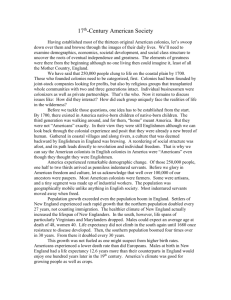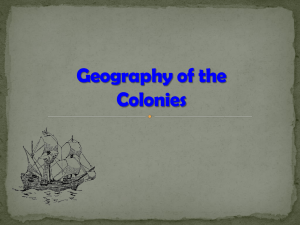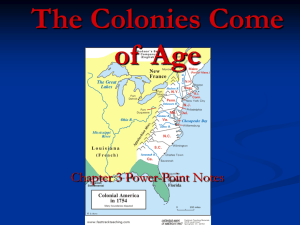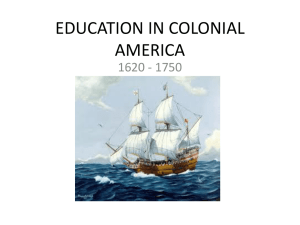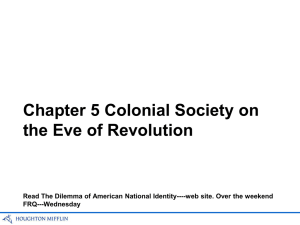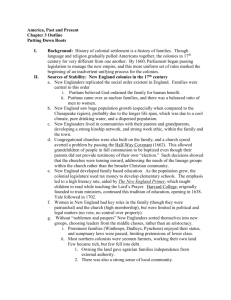Colonies
advertisement
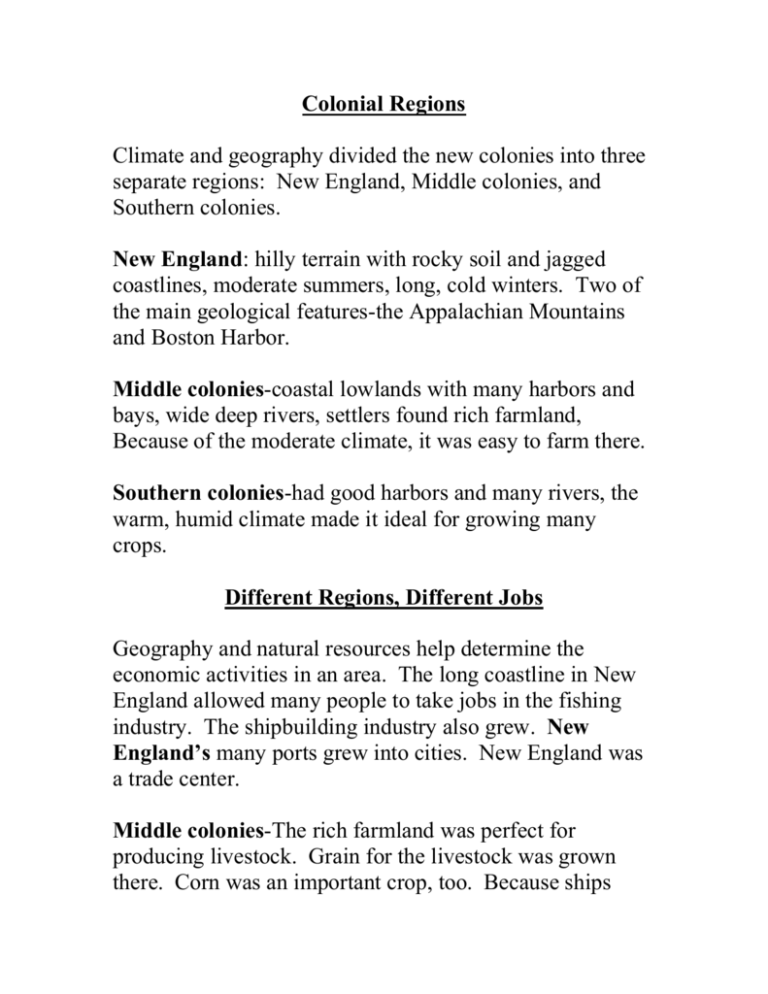
Colonial Regions Climate and geography divided the new colonies into three separate regions: New England, Middle colonies, and Southern colonies. New England: hilly terrain with rocky soil and jagged coastlines, moderate summers, long, cold winters. Two of the main geological features-the Appalachian Mountains and Boston Harbor. Middle colonies-coastal lowlands with many harbors and bays, wide deep rivers, settlers found rich farmland, Because of the moderate climate, it was easy to farm there. Southern colonies-had good harbors and many rivers, the warm, humid climate made it ideal for growing many crops. Different Regions, Different Jobs Geography and natural resources help determine the economic activities in an area. The long coastline in New England allowed many people to take jobs in the fishing industry. The shipbuilding industry also grew. New England’s many ports grew into cities. New England was a trade center. Middle colonies-The rich farmland was perfect for producing livestock. Grain for the livestock was grown there. Corn was an important crop, too. Because ships could easily come in and out, many coastal areas became major trading centers. Fishing was a key industry. Southern colonies-agriculture was very important. The mild climate was good for growing crops. The region had large plantations and small farms. Important cash crops included tobacco, rice, and indigo. Wood products were also important. Much of the hard work in the hot fields was done by slaves. Colonial Relationships The three colonial regions had different relationships. New England: people settled in villages and cities. Most settlements were formed by people seeking freedom of religion. The church was the center of social life. New England citizens got together at town meetings to discuss things affecting the town. Middle colonies: villages and cities were common. Colonists from many countries settled there. They brought different religions, traditions, and cultures. Most civic and political matters were settled in the large market towns. Southern colonies-lived on large or small farms, They grew food, made their own cloth and clothing, and did not have a lot of contact with others. Slaves and indentured servants were common. There were few cities or schools. The Church of England was the main church and center of social life. Southern colonies were divided into countiesthese were the centers of political and civic life. Colonial People Colonial Americans were divided into six groups: slaves, artisans, large landowners, farmers women, and indentured servants. Wealth and gender were the main factors deciding a person’s lot in life. Men usually had more privileges than women, and wealthy people had more opportunities to become educated and enjoy social affairs. Large landowners-lived in the south, usually owned large amounts of land and were wealthy, farms were called plantations, farms produced crops such as tobacco, sugar, and indigo, had slaves and indentured servants to work, often educated, enjoyed a rich social life. Farmers-not as wealthy as large landowners, worked themselves with their family, location decided what was produced. In New England, they raised livestock such as sheep. In the Middle colonies, they grew tobacco and grains, and in the South they grew rice, indigo, cotton, and tobacco. Artisans-settled in all areas of the colonies, worked as craftsmen in towns and on plantations, lived in small villages and cities, sometimes women were artisans. Women were caretakers, house workers, and homemakers. They had no political rights, were not allowed to vote, and had little chance of getting an education. Indentured servants-usually couldn’t afford to pay for a trip to America so they would find a ship captain to transport them. The captain would take them to a colony and contract with a merchant, artisan, or plantation owner to employ the indentured servant for a set amount of time (usually 3-5 years). When the time was up, the indentured servant was free to start a life of his own. Slaves-didn’t choose to come to the colonies but were captured in their native Africa and sold to slave traders. Once someone was enslaved he/she would be a slave all of his/her life. Even children born to slaves would be slaves forever. Slaves were not seen as human beings but rather as property. They had no rights and were often mistreated. Native Americans-Lived in the same area as the colonists. Native Americans helped the colonists & traded with them. Problems arose as the colonists took over lands that the NA lived on. Colonial Choices Behavior and choices affected price incentives. Colonists decided what to produce based on two things: (1) they produced things from raw materials in the area they lived and (2) they produced things other countries wanted & that would make money. What’s Your Specialty? Specialization-an efficient way to work, & there is a lower cost to produce items. New England specialized in the fishing, timber, and shipbuilding industries. Middle-had rich farmland. Farmers produced large harvests of wheat, rye, and corn. They raised livestock & fishing was an important industry. Southern-Agriculture was king. Plantations were very profitable because they grew tobacco, indigo, rice, & cotton on a large scale. Will You Exchange This? A system of voluntary exchange was used in colonial times. Colonists swapped goods they had for things they needed. Colonists exchanged goods with Indians regularly. Trade With Me! Trade between the colonies and England was important because it strengthened the economies of both countries.



